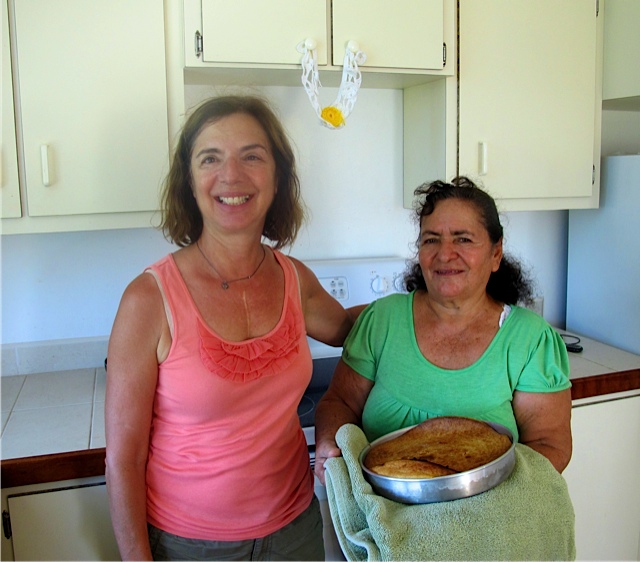
Miss Estella and Me
My favorite way to learn a new, global dish is to observe in kitchens of native cooks. Occasionally I am able to convince some women (no men so far) to let me watch them make a particular recipe – in their kitchen, using their own pots and pans and culinary tools. Cups may be measured in tea glasses, teaspoons with eating utensils or in the palm of a hand. I try to be helpful and participate if they will let me, and I certainly assist with cleanup. What an eye opener this is!
But it’s not easy. Cooks can be territorial – I know from personal experience. I almost hate to admit this, but it makes me really, really anxious if someone cooks in my kitchen unless they are supervised by me or are as tidy as I am. I like to consider myself a “control enthusiast.”

In Estella’s kitchen
Luckily, my neighbor in San Pedro, Miss Estella, recently welcomed me into her kitchen with open arms. She always delivers gifts from her kitchen when I arrive – warm carrot bread, homemade chicken tamales, bread pudding. I find her delicacies THE best Belizean food I have eaten in this country, and I am a tough customer. Estella speaks absolutely zero English and my Spanish vocabulary is pretty bad – I know some basic verbs and a lot of nouns but I’m willing to try. We have known each other for just a month or so, and with help of a Belizean interpreter of sorts, I asked her if I could come to her home and watch her make bread pudding. Happily, she agreed so I contacted her husband to get a grocery list, thinking I’d head out for a quick trip to the store. Sounds easy, right? The list, written in Spanish, looked a little “off” to me, but I figured that if anything crucial was missing I’d jump on the bike and go to town mid-cooking. I later learned that dear Estella forgot to mention coconut milk and although she wrote baking soda, she really wanted baking powder.

The shopping list!
We somehow agreed to a Sunday morning cooking date, and I phoned first to confirm. Communicating by telephone? Priceless! At 7:30 am I cycled to the “tiendita” to purchase white bread, eggs, milk and everything else on the list, then at 9:00 A.M. climbed the steps to their house, groceries in hand. I brought my little camera, too. This is also tricky, because I find that if I start shooting too many pictures and focus on that aspect – the emotional connection with the cook is diminished. And forget about “staging” a beauty shot! Ditto taking notes. Soooo, what this really requires is a good memory, an ability to be fully present and a sharp desire to recall stories. I take more snapshots in my mind than with my camera. Quantities are never precise for most of these cooks but I have an uncanny ability to guestimate amounts.
In this case, Estella made a humongous quantity (one large, deep, full sheet aluminum pan plus a 10-inch flan pan size) of bread pudding. I knew as I watched her that I would want to add some raisins, leave the slices of bread more intact (I’ll make this with sliced challah) and perhaps add a bit of thickened pineapple juice or a syrup for for flavor.

Estella’s Bread Pudding
One of the best parts of communing with these cooks is the friendships I’ve built along the way. I learned a lot about Estella during our time in her kitchen. She is 61, I am 62 and we have both been married for 40 years. Estella lived in Honduras until 17 years ago and she brought out photo albums of her children, grandchildren, her house in Honduras, her parents (still alive and in their 80’s), and pictures of her as a little girl too. We spoke only Spanish for an hour and I visited with her and with her husband about our lives, our families, and our work. I think I even understood about 60% of what they said!
Cooking certainly bridges the differences in our lifestyles, and I sincerely hope she will give me another lesson when I return to San Pedro. (Note: a recipe for my own version of bread pudding will be posted next week!)




